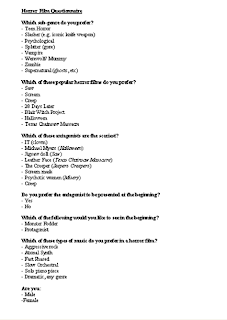 This is an example of the questionnaire i handed out to 20 people.
This is an example of the questionnaire i handed out to 20 people.From the results I discovered that most of the people preferred the sub-genre Splatter with 50%, whereas Teen Horror and Slasher were tied with 10% each. This shows that viewers are most likely to watch very graphic horror films.
60% of the people preferred the horror movie SAW over the rest of the films. 40% of that 60% were female showing that females prodominantly watch SAW over any other horror.
The results for the scariest antagonist were very close, Michael Myers was the most popular recieving 25% of the vote. The Antagonist from Stephen King's Misery recieved no votes at all. This shows that voters would prefer an antagonist with a mask as something symbolic.
100% of the voters wanted to see the antagonist at the beginning of the film, introducing the antagonist to keep viewers hooked.
75% of the voters enjoyed watching monster fodder at the beginning of the film, to show them how the antagonist kills.
55% of the voters preferred dramatic music of any genre. The least popular was atonal synth which recieved 5% of the votes; showing viewers prefer a score rather than anything experimental like Creep.






